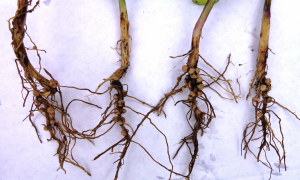Legume plants have the ability to form a symbiotic relationship with rhizobia bacteria, which fix nitrogen for the plant to use. The genus and species of rhizobia are specific to the legume which it infects. Inoculation offers selected rhizobia strains to help maximize nitrogen fixation and yield potential.
Nitrogen is one of the most critical components in crop production. Approximately 80% of the air is nitrogen gas, but it is not in a form that plants can use. Legume plants, however, have the ability to form a relationship with a specific soil bacteria, rhizobia, which convert nitrogen gas from the air into a readily available form that can be used by the plant. This process is known as nitrogen fixation and benefits both the plant and the farmer by supplying nitrogen to the crop. The plant-rhizobia relationship is a symbiotic (mutually beneficial) relationship, because each organism receives something from the other, and gives back something in return.2,3
Infection
Rhizobia bacteria are found in the soil, where they survive until legume plant roots are available to infect. There are many different rhizobia strains distributed among various species. In general, certain species nodulate a specific legume or multiple legumes with specific nodulation groups. When legume roots are present, the compatible rhizobia, through communication with the legume, will begin to multiply and attach to the root hairs of the plant.2 After they are attached, the rhizobia form an infection thread to enter the plant. Once inside the plant, the plant supplies all the nutrients that are necessary for the bacteria.3

Nodule Development
Nodules begin to develop as plant tissues surround the rhizobia and connective tissue forms through which food for the rhizobia, and nitrogen for the plant, pass through. Nodules can be seen on plant roots about 2 to 3 weeks after planting but may vary by legume species and plant growth. Nodules vary in size, shape, and color. Young nodules that have not yet started to fix nitrogen are white or grey inside. As nodules grow, they turn pink in the center (Figure 2), indicating that nitrogen fixation has begun. The pink or reddish color is caused by leghemoglobin, which helps regulate the oxygen within the nodule, similar to hemoglobin in blood.3

Nitrogen Fixation
Nitrogen fixation is the process of converting atmospheric nitrogen into a usable form for the plant. This biochemical reaction takes place in the root nodules formed by rhizobia bacteria. Rhizobia bacteria convert nitrogen gas (N2) into ammonia (NH3), and the legume plant provides the bacteria with carbohydrates as an energy source. The nitrogen fixed by the bacteria is the same form as in ammonium nitrate (34-0-0) and ammonium sulfate (21-0-0) fertilizer.2
Some legumes are better at fixing nitrogen than others. Grain legumes, such as soybean, are typically good at fixing nitrogen and may fix up to 250 lbs of nitrogen per acre. Perennial and forage legumes, like alfalfa, are capable of fixing 250 to 500 lbs of nitrogen per acre. These crops are typically not fertilized with nitrogen fertilizer.3
Factors influencing the amount of nitrogen fixed include plant growth, the rhizobia strain infecting the legume, and the amount of nitrogen in the soil. Anything that reduces plant growth, such as drought or nutrient deficiency, will also reduce nitrogen fixation. If nitrogen is available in the soil, the plant will use that before converting nitrogen from the air, thus reducing nitrogen fixation. The strains of rhizobia available are extremely important, as some are much better at fixing nitrogen than others.
Soil temperature also influences the rate of nitrogen fixation. The optimum soil temperature range for nitrogen fixation is 55° to 80° F; nitrogen fixation does not occur when the soil is 48° F or less. Under ideal conditions, the amount of nitrogen fixed can meet the needs of the crop, and leave nitrogen in the soil for following crops.1,2
Inoculation
Most legumes associate with a specific strain of rhizobia that maximizes nitrogen fixation. To help ensure that an effective rhizobia strain is present when planting a legume, the seed should be inoculated prior to planting. Many soils contain native strains of rhizobia bacteria, but they may vary widely in their ability to fix nitrogen. Less effective strains may produce many small nodules, but fix very little nitrogen, whereas effective rhizobia strains form fewer, but larger nodules with dark pink centers, indicating a healthy and active nodule.2,3
The addition of inoculant offers selected bacterial strains to help efficiently fix nitrogen. Soils that have a recent history of flooding or drought, or that have not been planted to that particular legume before, will especially benefit from inoculation. In addition, fields that have recently grown a particular legume may have native rhizobia present, but will still benefit from inoculated seed to help maximize yield potential.
Rhizobium inoculant contains live bacteria and should be stored according to label instructions until the time of use. All rhizobia inoculants have an expiration date, and should not be used or purchased if that date has passed. Inoculant can be added to the soil (direct-soil application) or to the seed (seed-applied inoculant).4
Sources:
1 Understanding Inoculation. 2003. A guide to higher yields from Nitragin.
2 Nitrogen fixation. Texas A&M University. http://overton.tamu.edu
3 Lindemann, W., and Glover, C. 2015. Nitrogen fixation by legumes. New Mexico State University A-129. http://aces.nmsu.edu
4 Inoculation of legumes for maximum nitrogen fixation. 2017. Penn State Extension. www.extension.psu.edu
Web sources verified 10/29/18